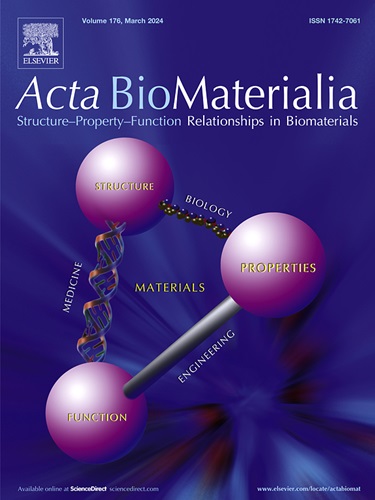构建压电、导电和可注射水凝胶,通过电刺激促进伤口愈合。
IF 9.4
1区 医学
Q1 ENGINEERING, BIOMEDICAL
引用次数: 0
摘要
压电、导电和可注射水凝胶(SPG 水凝胶)的构造可快速闭合伤口,从动物运动中有效采集生物力学能量,并产生电刺激用于伤口愈合电疗。将 3-氨基-4-甲氧基苯甲酸(AMB)单体聚合并接枝到明胶上,然后使用 EDC/NHS 进一步交联,并嵌入钛酸锶纳米颗粒(80.5 wt%),形成 SPG 水凝胶。这种 SPG 水凝胶具有很强的组织粘附能力,在机械弯曲时能产生输出电压(最大输出电压为 1 V)和电流(最大输出电流为 0.5 nA),促进 NIH-3T3 细胞迁移和增殖。在小鼠伤口模型上应用 SPG 水凝胶后,皮肤伤口迅速闭合,伤口外观平滑,剩余伤口面积缩小,表皮厚度增加,显示出显著的伤口愈合能力。这项研究表明,人体运动促进电疗法为伤口愈合提供了一种前景广阔的策略。意义说明:压电纳米材料通常被加入水凝胶中,形成用于伤口愈合的压电水凝胶。然而,压电纳米材料容易在水凝胶基质中聚集,而且水凝胶的低导电性阻碍了电子的有效传输。这两个因素加在一起,大大降低了压电效应。在本研究中,我们开发了一种 SPG 水凝胶,以提高压电水凝胶的均匀性和导电性。我们首先设计了一种导电 PG 水凝胶,然后通过配位化学将压电 STO 纳米粒子固定在其基质中。在机械变形时,均匀分布的 STO 纳米粒子可以产生电能,电能可以通过导电基质有效地传递到水凝胶表面。这种设计在伤口愈合方面具有巨大的应用潜力。本文章由计算机程序翻译,如有差异,请以英文原文为准。

Construction of piezoelectric, conductive and injectable hydrogels to promote wound healing through electrical stimulation
Piezoelectric, conductive, and injectable hydrogel (SPG hydrogel) is constructed to rapidly close wounds, efficiently harvest biomechanical energy from animal motion, and generate electrical stimulation for electrotherapy of wound healing. 3-amino-4-methoxybenzoic acid (AMB) monomer was polymerized and grafted onto the gelatin, which was further crosslinked using EDC/NHS and embedded with strontium titanate nanoparticles (80.5 wt%), forming SPG hydrogel. This SPG hydrogel had high tissue adhesion ability, and could generate the output voltage (maximum output voltage 1 V) and current (maximum output current 0.5 nA) upon mechanical bending, promoting NIH-3T3 cell migration and proliferation. Upon application to the mice wound model, the SPG hydrogel rapidly closed the skin wound, smoothed the wound's appearance, reduced the remaining wound size, and increased epidermal thickness, demonstrating remarkable wound healing capabilities. This study suggests that the body motion-promoted electrotherapy offers a promising strategy for wound healing.
Statement of significance
Piezoelectric nanomaterials are often incorporated into hydrogels to create piezoelectric hydrogels for wound healing. However, piezoelectric nanomaterials tend to agglomerate within the hydrogel matrix, and the hydrogel's low conductivity hinders efficient electron transfer. Together, both factors significantly reduce the piezoelectric effect. In this study, we developed an SPG hydrogel to improve the homogeneity and conductivity of the piezoelectric hydrogel. We first designed a conductive PG hydrogel and then immoblized piezoelectric STO nanoparticles within its matrix through coordination chemistry. Upon mechanical deformation, the uniformly distributed STO nanoparticles can generate electricity, which can efficiently transfer through the conductive matrix to the hydrogel's surface. This design shows great potential for wound healing applications.
求助全文
通过发布文献求助,成功后即可免费获取论文全文。
去求助
来源期刊

Acta Biomaterialia
工程技术-材料科学:生物材料
CiteScore
16.80
自引率
3.10%
发文量
776
审稿时长
30 days
期刊介绍:
Acta Biomaterialia is a monthly peer-reviewed scientific journal published by Elsevier. The journal was established in January 2005. The editor-in-chief is W.R. Wagner (University of Pittsburgh). The journal covers research in biomaterials science, including the interrelationship of biomaterial structure and function from macroscale to nanoscale. Topical coverage includes biomedical and biocompatible materials.
 求助内容:
求助内容: 应助结果提醒方式:
应助结果提醒方式:


